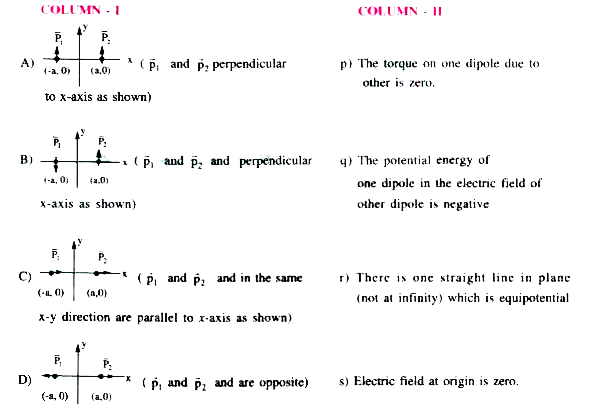In each situation of Column-I two elelctric dipoles having moments and of same magnitude are placed on x-axis symmetrically about origin in different orientations as shown. In column-II certain inferences are drawn for these two dipoles. Then match the different orientations of dipole in column-I with the corresponding result in column-II.

The correct Answer is:(A) p, r (B) p, q, s (C) p, q (D) r, s
Electric field due to an electric dipole at a point on equatorial line of dipole makes either or with the dipole moment of another dipole.
Torque on dipole becomes zero
Hence in column II.
[P] option is suit for every queries for column I. Electrostalic potential energy
Angle between moment & electric field.
[A] Here (+ve)
[B] Here (-ve)
-v
Topper's Solved these Questions
- MISCELLANEOUSBOOK - ALLENCHAPTER - MISCELLANEOUSEXERCISE - Exersice-04
1 Videos
- MISCELLANEOUSBOOK - ALLENCHAPTER - MISCELLANEOUSEXERCISE - Exercise-05
1 Videos
- MISCELLANEOUSBOOK - ALLENCHAPTER - MISCELLANEOUSEXERCISE - Exercise-03
1 Videos
- KINEMATICS (MOTION ALONG A STRAIGHT LINE AND MOTION IN A PLANE)BOOK - ALLENCHAPTER - KINEMATICS (MOTION ALONG A STRAIGHT LINE AND MOTION IN A PLANE)EXERCISE - BEGINNER S BOX-7
8 Videos
- PHYSICAL WORLD, UNITS AND DIMENSIONS & ERRORS IN MEASUREMENT BOOK - ALLENCHAPTER - PHYSICAL WORLD, UNITS AND DIMENSIONS & ERRORS IN MEASUREMENT EXERCISE - EXERCISE-IV
8 Videos
Similar Questions
In each situation of Column - I, two electric dipoles having dipole moments →p1and→p2 of same magnitude (that is,p1=p2) are placed on x-axis symmertrically about origin in different orientations as shown. In column - II certain inferences are drawn for these two dipoles. Then match the different orientations of dipoles in column - I with the corresponding results in column - II. [In column I the co-ordinates corresponding to the centres of dipoles and dipoles having the same dipole lenght]

View SolutionColumn-I shows different charge distributions. Cloumn-II gives corresponding electric dipole moments.

View Solution
Knowledge Check
Two point dipoles of dipole moment →p1and→p2 are at a distance x from each other and →p1∣∣→p2 . The force between the dipoles is :
A14πε04p1p2x4B14πε03p1p2x3C14πε06p1p2x4D14πε08p1p2x4
in column - I certain situations are shown Column-II has different values of phase difference Match them [take π2=10 wherever required]


View SolutionTwo wires each carrying a steady current i are shown in two different configurations in column I. The magnetic field produced due to current in the wires is described in column II. Match the situations A and B in column I with all the correct statements in column II.

View SolutionTwo short electric dipoles having dipole moment p1 and p2 are placed co-axially and uni-directionally, at a distance r apart. Calculate nature and magnitude of force between them :
View SolutionColumn I gives a situation in which two dipoles of dipole moment pˆi and √3pˆj are placed at origin. A circle of radius R with centre at origin is drawn as shown in figure. Column II gives coordinates of certain positions on the circle. Match the statements in Column I with the statements in Column II.

View SolutionColumn I gives a situation in which two dipoles of dipole moment pˆi and √3pˆj are placed at origin. A circle of radius R with centre at origin is drawn as shown in figure. Column II gives coordinates of certain positions on the circle. Match the statements in Column I with the statements in Column II.

View SolutionTwo identical electric dipoles of dipole moments p are placed as shown in the figure. The electrostatic force on dipole placed along x-axis is (d << r) (14πε0 )

View SolutionTwo wire each carrying a steady current I are shown in four configurations in Column I. Some of the resulting effects are described in column II. Match the statements in Column I with the statements in Column II.

View Solution
